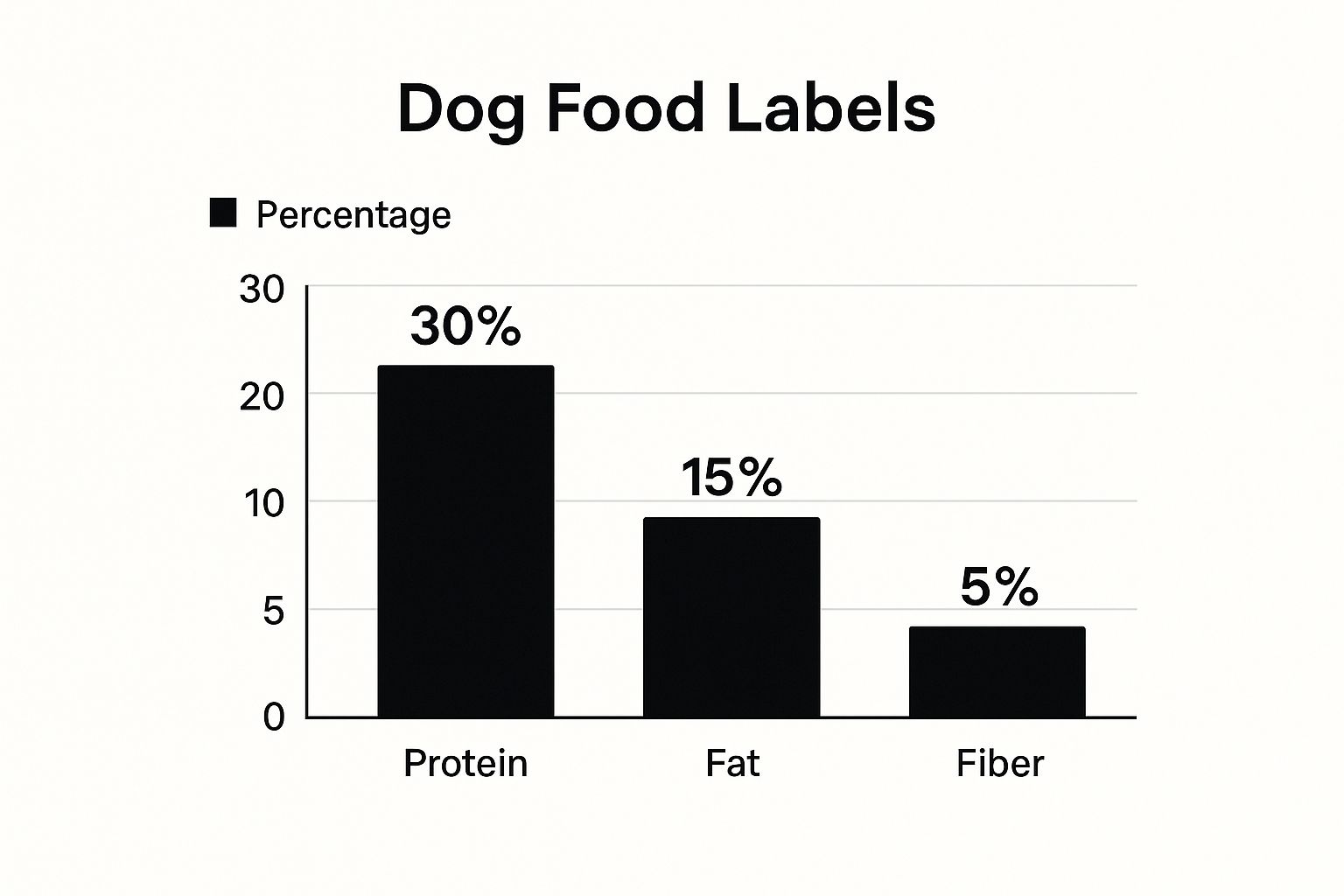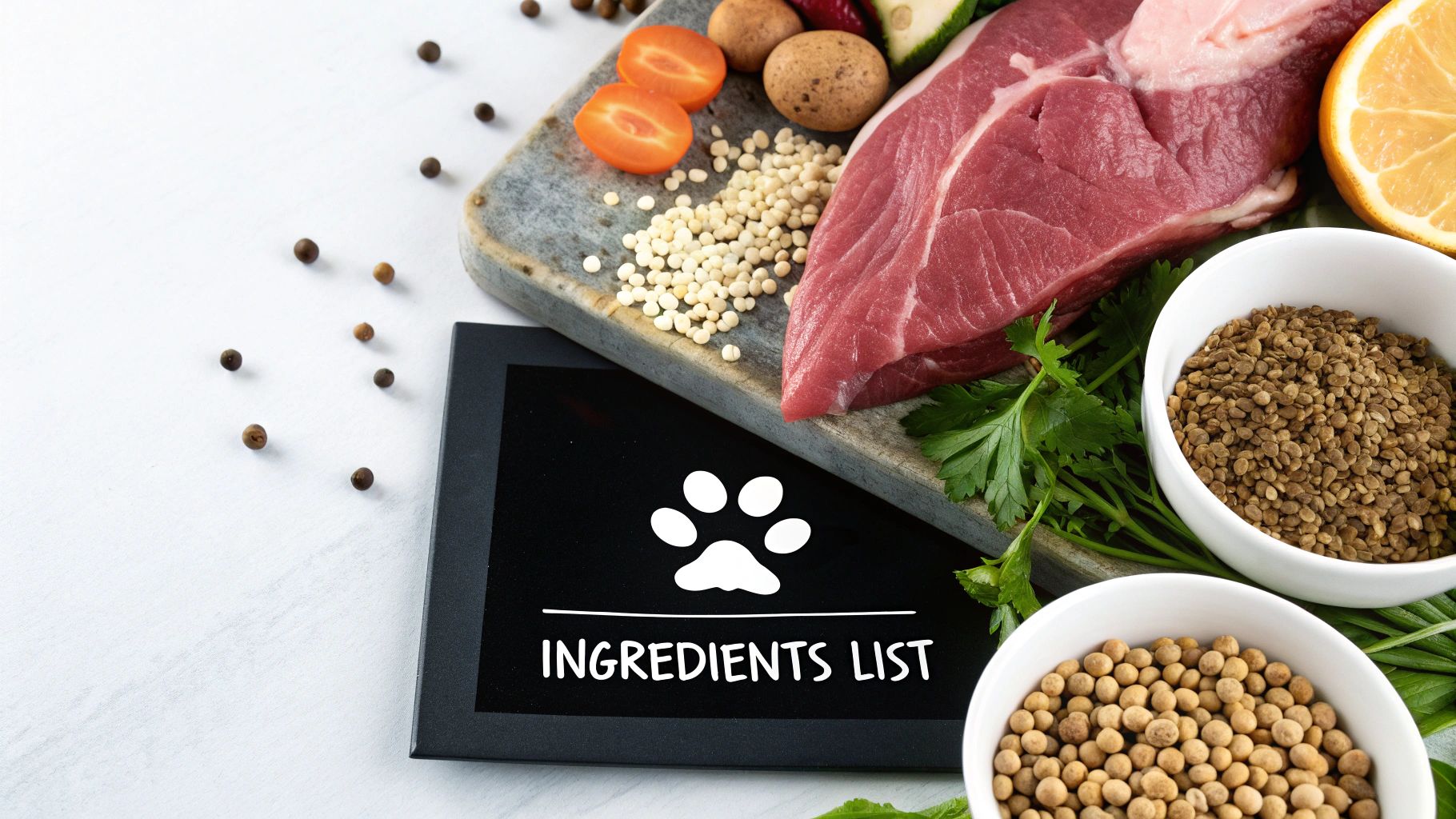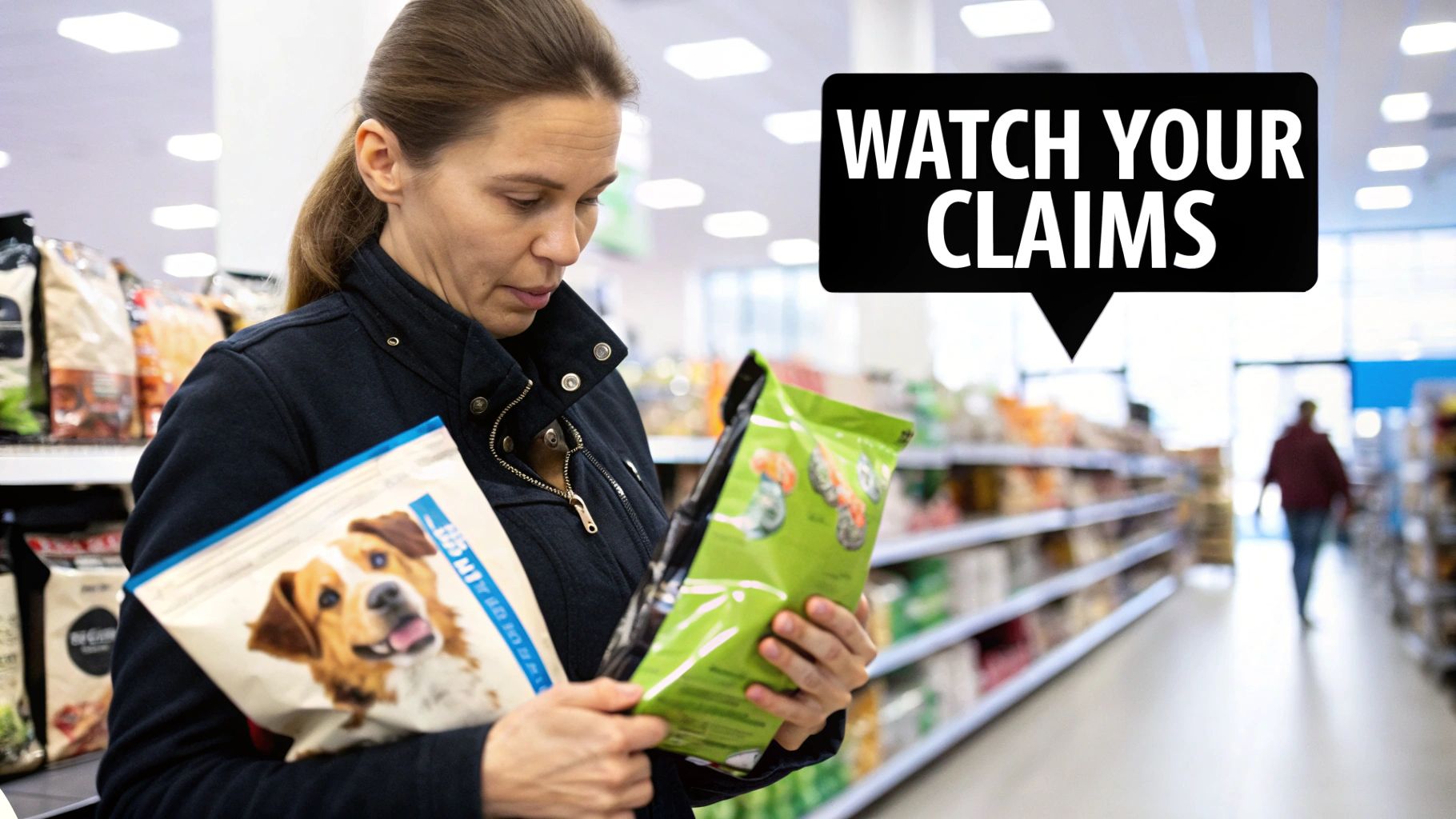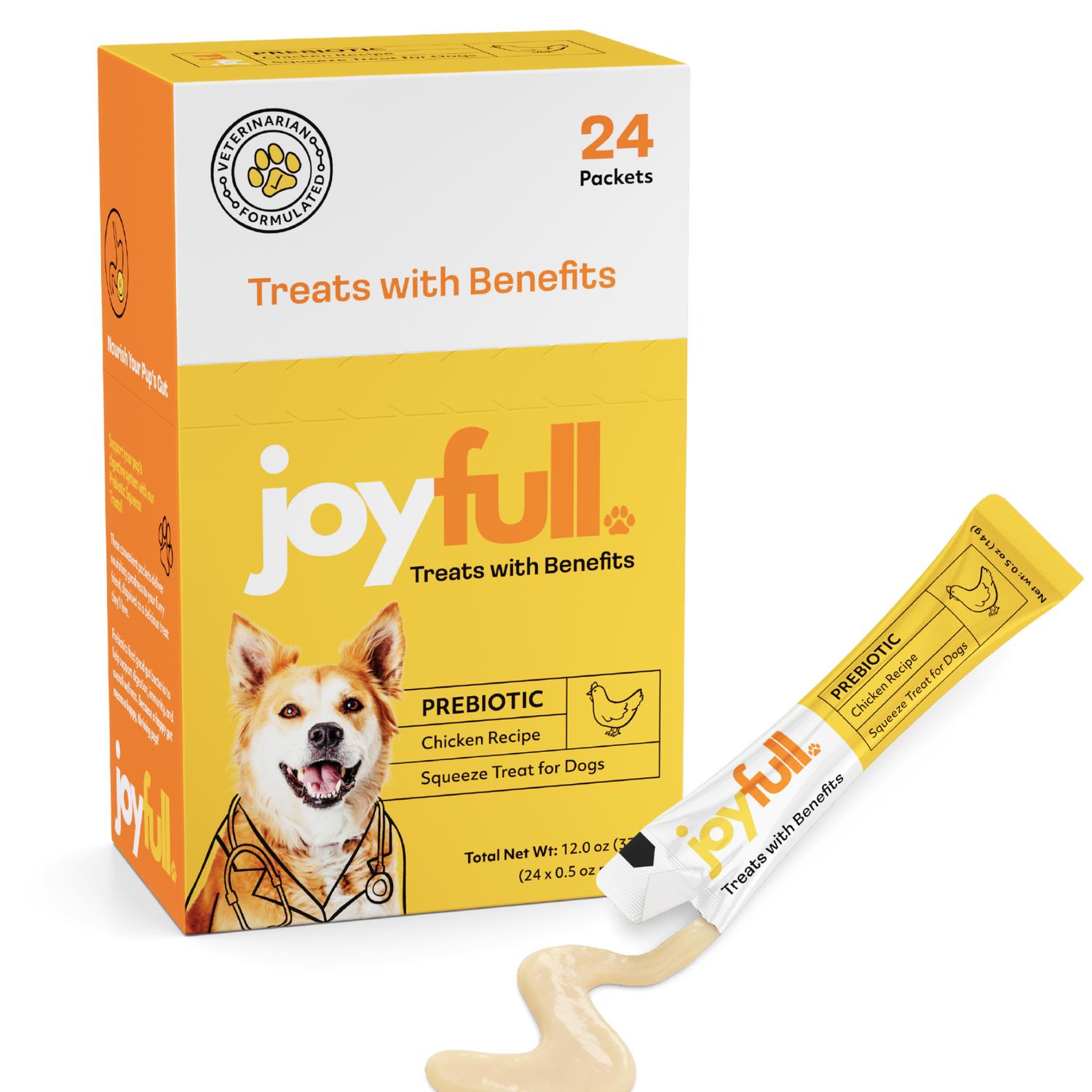
How to Read Dog Food Labels Like a Pro
When you're standing in the pet food aisle, the sheer number of options can be overwhelming. The key to cutting through the marketing noise is knowing exactly what to look for on that label. I always tell my clients to focus on three main things: the ingredient list, the guaranteed analysis, and the AAFCO nutritional adequacy statement.
Let's break down what really matters.
What Really Matters on a Dog Food Label

Most people's eyes jump right to the ingredient list. It feels like the most transparent part of the bag, but it has a few quirks you need to understand to get the full picture. The big secret? Ingredients are listed by weight before they're cooked.
This is a critical point. Whole ingredients like fresh "chicken" or "beef" are packed with water, which makes them heavy. Once the food is processed into kibble, a lot of that water evaporates. This means its actual contribution to the final product is often less than what its high ranking on the list might suggest.
Decoding Protein Sources
This is where you see the difference between an ingredient like "chicken" versus "chicken meal." It's a common point of confusion.
"Chicken" is the fresh meat you’d find in your own kitchen, and it’s about 70-80% water. "Chicken meal," on the other hand, is a rendered product. Most of the water and fat have been cooked out, leaving behind a highly concentrated protein powder.
While fresh meat sounds much better to us, a high-quality, named meat meal (like chicken meal or lamb meal) can actually provide a more powerful punch of protein in the final kibble because its weight isn't inflated by water.
When you're scanning those first five ingredients, a good sign is seeing a mix. A food that lists a fresh meat first, followed quickly by a high-quality meat meal, usually has a solid protein base. This same principle applies when you're looking for healthiest treats for your dog—always check the protein source.
What to Look For and What to Avoid
To make sure you're getting a quality food, keep your eyes peeled for specific, named ingredients and be skeptical of anything that sounds vague.
- Look for: Clearly named proteins like "deboned chicken," "lamb meal," or "salmon." The more specific, the better.
- Avoid: Ambiguous terms like "meat and bone meal" or "animal by-products." These mystery meats don't tell you the source, which can be a red flag for lower-quality, inconsistent ingredients.
Thankfully, reading these labels is getting a bit easier. In 2023, the Association of American Feed Control Officials (AAFCO) rolled out its first major label update in over 40 years, all designed to be more helpful for pet owners. These new rules are pushing for more transparency and standardization, which is a big win for all of us.
Unpacking the Guaranteed Analysis Panel
At first glance, the Guaranteed Analysis panel on a dog food label looks a lot like the nutrition facts on our own food. But it tells a very different story. The numbers you see are guarantees, not exact amounts. This means they show the minimum percentages of protein and fat, and the maximum percentages for fiber and moisture.
Think of it this way: the manufacturer guarantees there's at least a certain amount of protein and no more than a certain amount of moisture. It’s a baseline, not a precise measurement of what’s in every single scoop.
This is where things get tricky, especially when you're trying to compare different types of food. A canned food listing 8% crude protein might look seriously lacking next to a dry kibble boasting 26% crude protein. But appearances can be deceiving, and it all comes down to the water content.
The Power of a Dry Matter Basis Calculation
To get a true apples-to-apples comparison, you need to look at the nutrients on a dry matter basis (DMB). This simple calculation strips out all the moisture, revealing the true concentration of protein, fat, and fiber. Honestly, it's the most reliable tool you have for accurately comparing a wet food to a dry one.
Let's walk through a real-world example. Say you're looking at a canned food with these numbers:
- 78% Maximum Moisture
- 9% Minimum Crude Protein
First, you figure out the total dry matter by subtracting the moisture from 100%. 100% - 78% (Moisture) = 22% Dry Matter
Now, just divide the protein percentage by that dry matter figure. 9% (Protein) ÷ 22% (Dry Matter) = 40.9%
Suddenly, that "low protein" canned food actually contains nearly 41% protein on a dry matter basis. That's a protein-packed meal, likely far more concentrated than many premium kibbles on the shelf.
This table below really drives the point home, showing just how different the numbers look once you account for moisture.
Guaranteed Analysis vs. Dry Matter Basis Comparison
This table illustrates how converting to a dry matter basis reveals the true nutritional content of different dog food types, enabling a more accurate comparison.
| Nutrient | Canned Food (As-Fed) | Canned Food (Dry Matter Basis) | Dry Kibble (As-Fed) | Dry Kibble (Dry Matter Basis) |
|---|---|---|---|---|
| Protein | 8% | 36.4% | 26% | 28.9% |
| Fat | 6% | 27.3% | 16% | 17.8% |
| Fiber | 1% | 4.5% | 4% | 4.4% |
| Moisture | 78% | 0% | 10% | 0% |
As you can see, the canned food, which initially appeared lower in protein and fat, is actually significantly more nutrient-dense once the water is removed from the equation. This is why you can't just trust the numbers on the bag.

Never judge a food by its "as-fed" percentages alone. A quick DMB calculation can completely change your perspective and help you make a much more informed choice for your dog's health.
Decoding the AAFCO Nutritional Adequacy Statement

So, you’ve scanned the ingredients and checked the guaranteed analysis. Now it's time to find what I consider the most important piece of information on the entire bag: the AAFCO nutritional adequacy statement.
This small, often overlooked block of text tells you if the food is genuinely complete and balanced for your dog's specific needs. AAFCO doesn't approve or certify products, but they do set the science-backed nutritional standards. If a food doesn't have this statement, it's not meant to be your dog's main meal.
Formulated vs. Feeding Trials: What’s the Difference?
When you read that statement, you’ll see one of two key phrases. They both meet minimum requirements, but they aren't created equal.
- Formulated to meet: This means the recipe was created on a computer to theoretically match the AAFCO nutrient profiles. It's nutrition by the numbers.
- Animal feeding trials: This is the big one. It means the company actually fed that specific food to dogs for an extended period under strict AAFCO protocols to prove they did well on it.
Feeding trials are the gold standard. They provide real-world proof that the recipe works in actual dogs, not just on paper. It confirms that the nutrients are bioavailable—meaning your dog can absorb and use them. Think of it as the difference between a recipe that should be healthy and one that’s been proven to be.
Matching the Food to Your Dog's Life Stage
The AAFCO statement also tells you who the food is for. This is non-negotiable; you have to match the food to your dog's stage in life.
You’ll typically see one of these designations:
- Growth: Specifically for puppies.
- Adult Maintenance: For healthy, adult dogs with normal activity levels.
- All Life Stages: Meets the more demanding nutritional needs of puppies, which means it's also fine for most adults.
Giving a puppy food labeled for "adult maintenance" is a recipe for potential developmental issues down the road. Always check that the AAFCO statement lines up perfectly with your dog's current age and needs.
Seeing Through Marketing Buzzwords
https://www.youtube.com/embed/noiJt0vLV9k
The front of a dog food bag is prime real estate, and brands use it to grab your attention with appealing claims. You'll see words like "premium," "gourmet," or "holistic" everywhere. They sound great, but the truth is, they have zero legal or regulatory definition according to the Association of American Feed Control Officials (AAFCO). They're just marketing fluff.
Don't dismiss every word, though. Some claims actually mean something specific. If a bag says "natural," it’s a defined term. It means the ingredients come only from plant, animal, or mined sources. Synthetic additives are out, though they can still add essential vitamins and minerals.
"Human-grade" is another regulated term, and it’s a high bar to clear. For a food to earn this claim, every single ingredient and the final product must be handled, stored, and processed under the same strict federal regulations as food for people.
What's in a Name? Turns Out, A Lot.
The product's name isn't just a creative choice—it's governed by strict rules that reveal a ton about what’s inside. AAFCO has specific percentage rules that dictate how brands can name their recipes. Learning them is like having a secret decoder ring for dog food.
These naming rules are your first real clue about the food's composition. Before you even flip the bag over to the ingredient list, the name itself tells a story about how much of that "star" ingredient is actually in the recipe.
Here’s how to crack the code:
-
The 95% "Simple Name" Rule: When you see a simple name like "Beef for Dogs," beef must make up at least 95% of the product's total weight (not counting water). If it's "Chicken & Rice Dog Food," then chicken and rice combined must hit that 95% mark.
-
The 25% "Dinner" Rule: This one is a bit trickier. When you see descriptive words like "dinner," "platter," "entrée," or "formula" (think "Chicken Dinner"), the named ingredient only has to be 25% of the total weight.
-
The 3% "With" Rule: This little word makes a huge difference. A bag labeled "Dog Food with Chicken" only needs to contain 3% chicken. It’s a classic way to highlight an ingredient that’s really only there in small amounts.
-
The "Flavor" Rule: If the name says "Chicken Flavored Dog Food," it only needs to contain enough chicken (or chicken by-products) for a dog to taste it. There's no minimum percentage required at all.
Once you know these rules, you can walk down the pet food aisle and instantly tell if that bag of "Salmon Entrée" is truly packed with fish or just giving it a nod. It’s a game-changer.
Using Feeding Guidelines and Calorie Counts

So, you've flipped the bag over and found the feeding chart. It's a great starting point, but that's all it is—a start. These charts are based on an "average" dog, and let's be honest, your dog is anything but average.
These recommendations can't possibly know your dog's unique metabolism, breed-specific needs, or whether they've been spayed or neutered. Think about it: a high-octane Border Collie running circles in the yard will burn far more calories than a Basset Hound of the same weight whose biggest daily challenge is getting comfortable on the sofa.
This is where understanding the calorie count becomes your most powerful tool.
Find the Calorie Statement
Tucked away near the guaranteed analysis, you'll find the calorie statement. It will list calories as "kcal/kg" (kilocalories per kilogram) and, far more practically, as "kcal/cup." This second number is your golden ticket. Knowing the exact calories per cup is what allows you to make precise adjustments and avoid unintentional weight gain.
Your dog’s individual needs should always be the final word on their portion size. Start with what the bag suggests, but watch your dog’s body condition closely and be ready to adjust. You should be able to feel their ribs easily (but not see them) and notice a slight "waist" when looking down from above.
It's also worth noting that pet food labels are shaped by different rules depending on where you live. In the United States, for instance, the FDA's Food Safety Modernization Act (FSMA) of 2011 ramped up safety requirements, forcing manufacturers to focus on preventing contamination before it happens.
Finally, don't forget that kibble is only part of the equation. Every treat and scrap counts toward their daily total! If you're in a heavy training phase, those rewards can add up quickly. Make sure you're choosing wisely by checking out our guide on the best training treats for dogs.
Your Common Questions About Dog Food Labels Answered
Even after getting the hang of the main panels, it's normal to still have some lingering questions. The dog food aisle can feel like a maze of confusing terms and myths that just won't quit.
Let's clear up some of the most common questions I hear from pet owners. My goal is to help you cut through the noise and shop with complete confidence.
What Is the Difference Between By-Products and Meal?
This is probably one of the biggest points of confusion, and the industry language doesn't help. Let's break it down simply.
A named meat meal, like "chicken meal," is essentially a concentrated protein powder. Manufacturers take the whole meat, cook it down to remove most of the water and fat, and what's left is a very dense, protein-packed ingredient. It's not a bad thing; in fact, it's a potent way to get high levels of protein into kibble.
By-products, on the other hand, are the clean parts of an animal that aren't muscle meat. Think of nutrient-dense organs like the liver, spleen, and lungs. While the word "by-product" sounds a bit off-putting, these parts can be incredibly nutritious. The key is to look for named sources, like "chicken by-products." A vague term like "animal by-products" is a major red flag and should be avoided.
Is Grain-Free Dog Food Better?
The grain-free craze really took over the pet world, but it's not automatically the best choice for every dog. For a while, the FDA was investigating a potential link between certain grain-free foods (especially those with lots of peas and lentils) and a heart condition known as dilated cardiomyopathy (DCM).
Your veterinarian is your best resource here. A true grain allergy in dogs is actually pretty rare. Many dogs do incredibly well on foods that include wholesome grains like brown rice or oatmeal, which are great sources of fiber and key nutrients.
How Can I Tell If a Brand Is Trustworthy?
This is where you need to do a little detective work beyond the bag itself. A truly high-quality brand will be proud of its standards and transparent about its process.
Here are a few questions I always ask when evaluating a brand:
- Do they have qualified experts, like full-time veterinary nutritionists, on staff?
- Do they actually own the manufacturing plants where their food is made?
- Do they invest in and publish their own nutritional research?
- Are they open about their quality control measures and safety tests?
A company that puts its money into these areas is showing a commitment to quality, not just slick marketing. This same level of scrutiny should apply to everything your dog eats, including their snacks. Finding the best dog treats for dental health means applying the same careful eye to the treat bag.
At Joyfull, we're built on a foundation of total transparency because we know your pet's health comes first. We use clean, science-backed ingredients and work with our in-house veterinary advisor to ensure you never have to second-guess what's going into their bowl. See what makes us different at https://joyfullpet.com.

